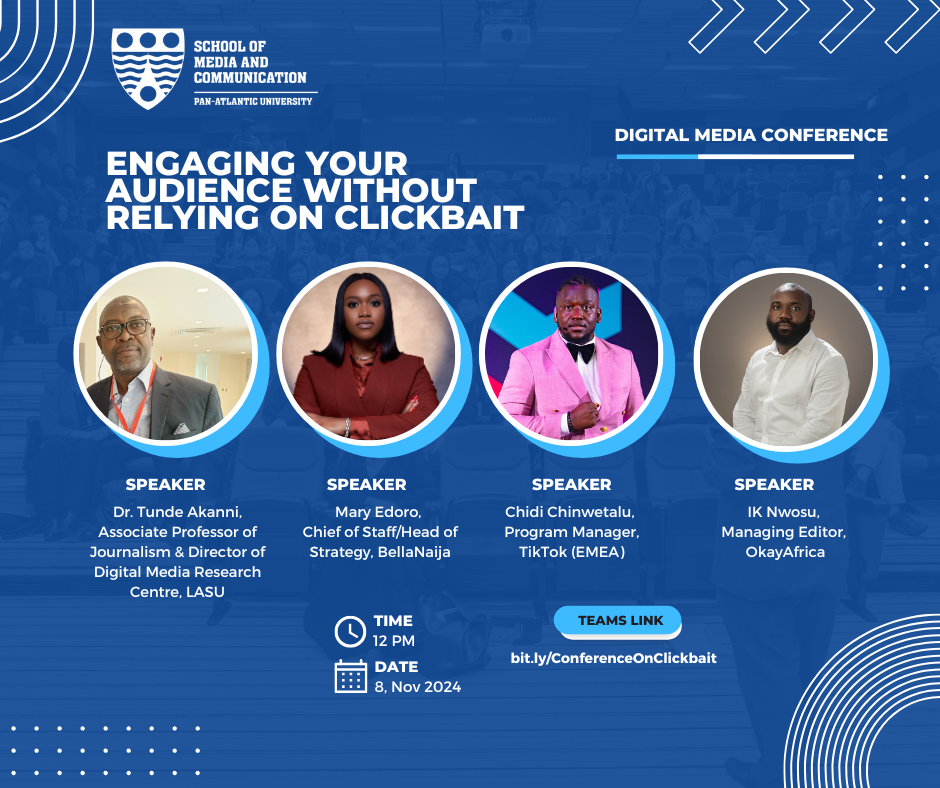
The digital age has changed the way we consume information. Platforms like TikTok, Instagram, LinkedIn, and X (formerly Twitter) have transformed how media outlets engage with their audiences. In this race for attention and advertising revenue, some media outlets have resorted to a tactic known as clickbait.
In this new reality, media outlets are under immense pressure to capture audience attention, often resorting to clickbait tactics to compete for views, likes, and advertising revenue. While this strategy can drive short-term engagement, it risks undermining long-term trust and credibility. Clickbait—designed to lure audiences with sensationalised headlines and incomplete information—has become commonplace in today’s media landscape.
From exaggerated captions on Instagram to misleading headlines on news blogs, clickbait thrives on curiosity but often leaves audiences disappointed. To address this pressing issue, I organised a virtual conference titled “ Engaging Your Audience Without Relying on Clickbait” as part of my commitment as an MSc Media and Communication student at Pan-Atlantic University. The event brought together industry experts, including Mary Edoro , Chief of Staff and Head of Strategy at BellaNaija; IK Nwosu , Managing Editor at OkayAfrica; Chidi Chinwetalu , Program Manager at TikTok; and Dr.
Tunde Akanni , Associate Professor of Journalism at Lagos State University, to discuss ethical ways to engage audiences without sacrificing credibility. The Dilemma of Clickbait: Short-Term Gains, Long-Term Losses Opening the discussion, Dr. Tunde Akanni said clickbait is the digital equivalent of sensationalism in traditional media.
He explained that, “Just as tabloids used exaggerated headlines to sell papers, online platforms use similar tactics to capture attention.” However, he cautioned that the rapid shift to digital-first consumption has raised the stakes, requiring audiences to develop “digital literacy” to discern reliable content from exaggerated claims. Mary Edoro highlighted the pressures media organisations face to remain relevant in a fast-paced, attention-driven landscape.
“For millennials, who grew up with traditional media, digital platforms must grab attention quickly. Clickbait thrives on this need for instant engagement, but it often sacrifices context and depth,” she explained. Why Media Turns to Clickbait When asked why media organisations resort to clickbait, IK Nwosu offered a blunt response, “Short answer: Money.
” He explained that media outlets operate under significant financial pressure, and advertisers now demand detailed metrics, from user demographics to engagement rates. “Clickbait drives traffic, but it doesn’t build loyalty,” IK said. “Audiences are more digitally savvy now and can see through exaggerated claims.
They bounce off quickly when they feel misled, leading to high bounce rates and low retention.” He emphasised that building meaningful, long-term connections with audiences requires more than just flashy headlines—it demands trust. Navigating the Clickbait Trap in Video Content Chidi Chinwetalu addressed the unique challenges of creating engaging video content without falling into the clickbait trap.
“The shift to video-first platforms like TikTok has created new expectations. Within three seconds, your video has to grab attention,” Chidi said. However, he acknowledged that balancing ethical storytelling with engagement is not always straightforward.
Creators face immense pressure to “stop the scroll,” often resorting to sensational tactics. Yet, Chidi emphasised that authenticity wins in the long run. “Creators who prioritise meaningful content build loyal communities, even if their engagement grows slower.
It’s about finding a balance between grabbing attention and maintaining credibility.” Building Ethical Engagement Strategies As the conference progressed, the conversation shifted to solutions. Dr.
Akanni said that moderation is key, stating, “Clickbait isn’t inherently bad—it depends on how it’s used. Ethical content creation means balancing attention-grabbing tactics with truthful storytelling.” IK Nwosu suggested a shift toward community-building strategies.
“Mass media is fading; communities are the future,” he said. Platforms like TikTok, newsletters, and niche social groups allow creators to connect with smaller, more engaged audiences who value authenticity over sensationalism. Mary Edoro encouraged media organisations to educate their audiences about media literacy.
“While individuals have a responsibility to discern credible content, media outlets must also guide their audiences. Transparency and ethical storytelling are non-negotiable in today’s media ecosystem.” Final Thoughts The conference highlighted the challenges and opportunities in today’s digital media landscape.
While clickbait may offer quick wins, it often comes at the cost of audience trust. The solution lies in balancing engagement with ethics, building communities, and fostering digital literacy. I summarised by emphasising the need for digital media to build credibility.
I said that, “The media landscape is changing, and we all have a role to play—content creators, platforms, and audiences alike. Together, we can create a digital environment where engagement doesn’t come at the expense of credibility.”.














